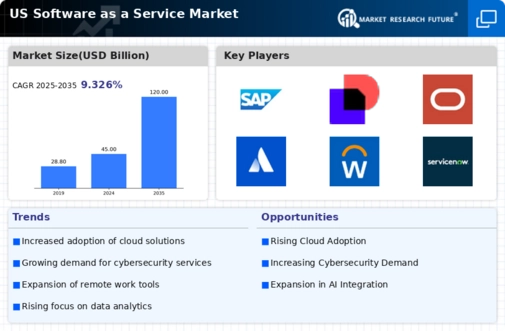Integration of Advanced Analytics
The integration of advanced analytics into software as-a-service offerings is reshaping the landscape of the market. Businesses are increasingly seeking data-driven insights to enhance decision-making processes. In 2025, it is anticipated that over 60% of software as-a-service solutions will incorporate analytics capabilities, allowing organizations to leverage real-time data for strategic planning. This trend not only improves operational efficiency but also fosters innovation, as companies can identify emerging trends and customer preferences. The software as-a-service market is thus positioned for substantial growth, with an expected increase in revenue of approximately $50 billion by 2026, driven by the demand for analytics-enhanced solutions.
Rising Demand for Remote Work Solutions
The software as-a-service market experiences a notable surge in demand for remote work solutions. As organizations increasingly adopt flexible work arrangements, the need for cloud-based applications that facilitate collaboration and productivity becomes paramount. In 2025, it is estimated that approximately 70% of companies in the US will utilize some form of remote work software, driving the growth of the software as-a-service market. This shift not only enhances employee satisfaction but also reduces operational costs, as businesses can scale their software needs according to fluctuating workforce requirements. Consequently, the software as-a-service market is likely to expand, with a projected growth rate of around 20% annually, reflecting the ongoing transformation of workplace dynamics.
Growing Importance of Cloud Infrastructure
The growing importance of cloud infrastructure is a pivotal driver for the software as-a-service market. As organizations increasingly migrate their operations to the cloud, the demand for robust and scalable software solutions intensifies. In 2025, it is anticipated that cloud infrastructure spending in the US will exceed $100 billion, reflecting the critical role of cloud services in supporting software as-a-service applications. This trend not only enhances accessibility and collaboration but also reduces the need for on-premises hardware, leading to cost savings for businesses. As a result, the software as-a-service market is poised for continued expansion, with an expected growth trajectory of around 15% annually, driven by the increasing reliance on cloud technologies.
Emphasis on User Experience and Customization
User experience and customization are becoming critical drivers in the software as-a-service market. As competition intensifies, providers are focusing on delivering tailored solutions that meet the specific needs of diverse industries. In 2025, it is estimated that 75% of software as-a-service applications will offer customizable features, enabling businesses to adapt the software to their unique workflows. This emphasis on user-centric design not only enhances customer satisfaction but also fosters loyalty, as organizations are more likely to remain with providers that understand their requirements. Consequently, the software as-a-service market is expected to grow significantly, with a projected increase in user adoption rates of approximately 30% over the next few years.
Shift Towards Subscription-Based Pricing Models
The software as-a-service market is witnessing a significant shift towards subscription-based pricing models. This approach offers businesses greater flexibility and cost predictability, allowing them to allocate resources more efficiently. In 2025, it is projected that nearly 80% of software providers will adopt subscription models, catering to the evolving preferences of customers who favor pay-as-you-go options. This trend not only democratizes access to advanced software solutions but also encourages continuous updates and improvements, enhancing user experience. As a result, the software as-a-service market is likely to see a compound annual growth rate (CAGR) of around 25% over the next five years, reflecting the increasing acceptance of subscription pricing.

















Leave a Comment